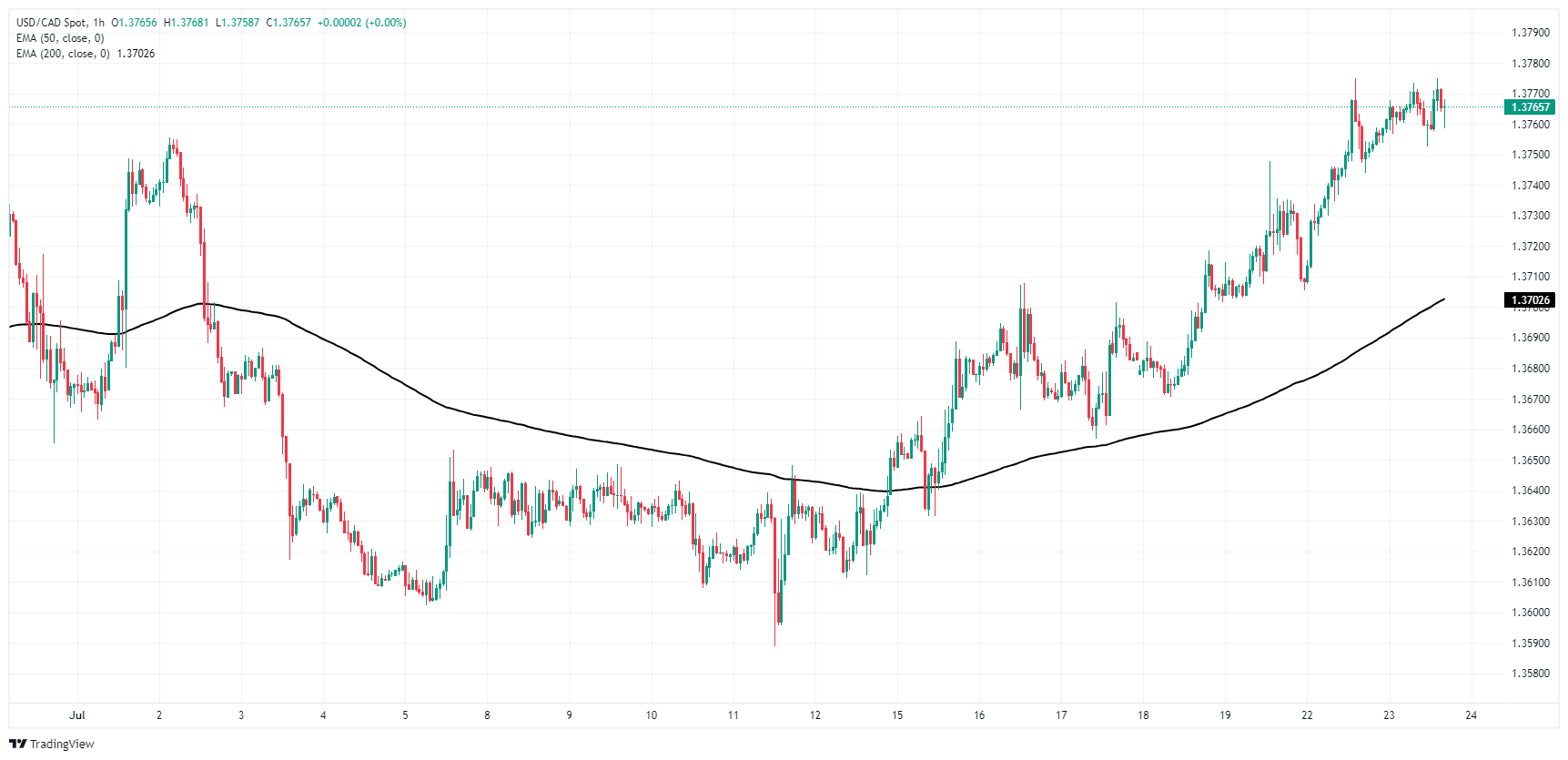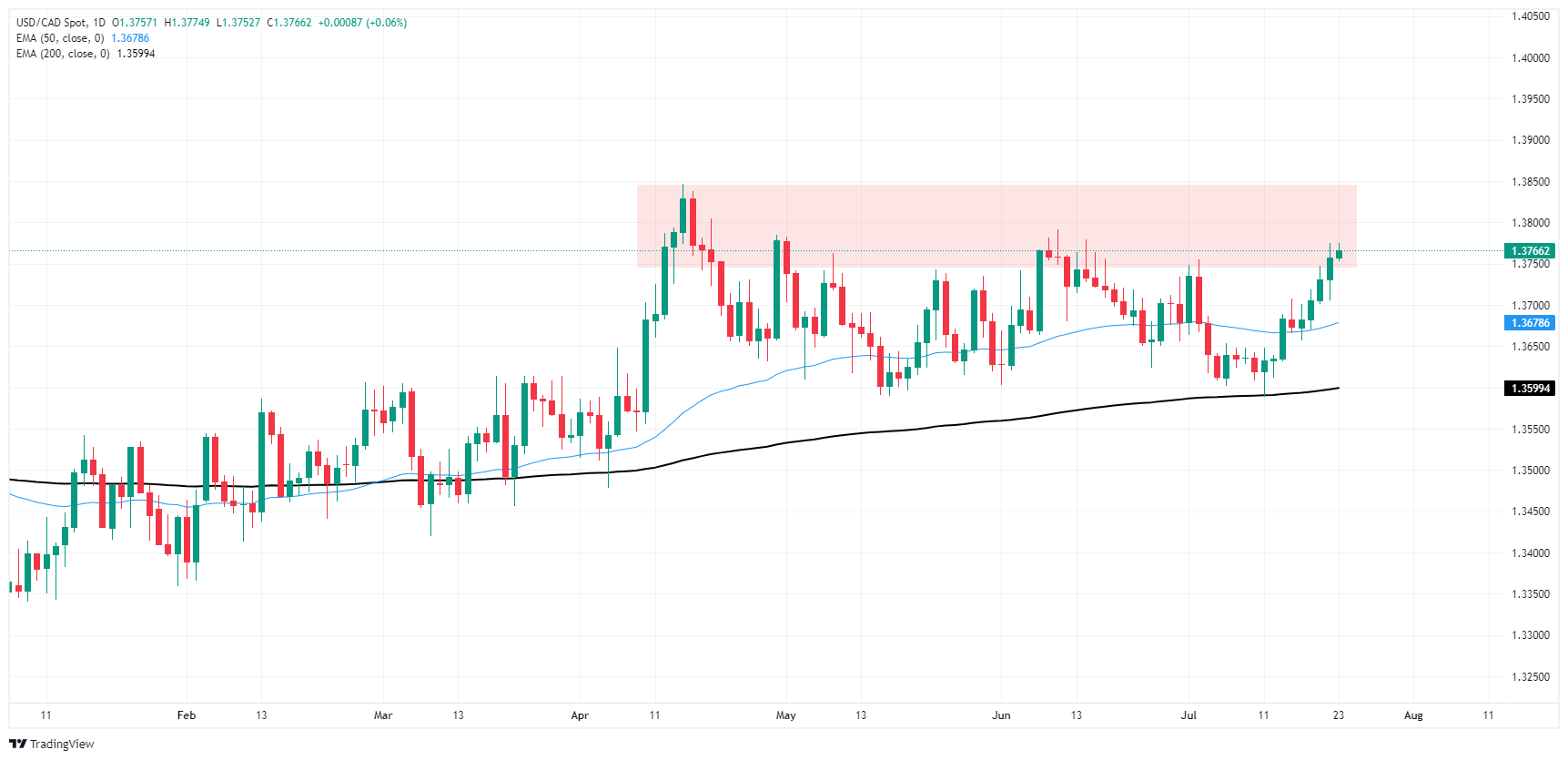- Аналітика
- Новини та інструменти
- Новини ринків
- Canadian Dollar continues pre-BoC churn on Tuesday
Canadian Dollar continues pre-BoC churn on Tuesday
- Canadian Dollar finds gains, but remains slightly lower against the Greenback.
- Canada is set to deliver another BoC rate cut despite near-term inflation uptick.
- Key US data due this week will likely overshadow BoC moves.
The Canadian Dollar (CAD) mostly paddled in place on Tuesday, finding thin gains across the board but still struggling to make headway against a mild recovery in US Dollar bidding. A quiet start to the trading week is set to give way to a moderately hectic second half beginning with Wednesday’s expected rate trim from the Bank of Canada (BoC) and a raft of key data prints from the US in a three-day binge.
Canada is all set to deliver another quarter-point rate cut on Wednesday after the BoC boxed itself into a promised series of rate cuts in the latter half of 2024. Despite a near-term uptick in core inflation metrics that would normally worry a major central bank, the BoC is determined to shrug off a data-dependent approach. Instead, the BoC is determined to soothe broad-market demands for cheaper debt financing costs.
Daily digest market movers: Canadian Dollar coils ahead of mid-week rate call
- CAD markets are poised for a broadly-anticipated BoC rate cut. Investors are broadly expecting a 25 bps trim as a follow-up to June’s initial quarter-point cut.
- Too many cuts too fast could easily tip the Canadian economy into an inflation-hot recession with key price growth indicators already flashing warning signs after June’s cut.
- Canada’s housing market already represents an outsized proportion of the Canadian economy, nearly twice the OECD average. Declining rates could spark a fresh flurry in the real estate market, further burdening Canada with long-dated consumer debt and reigniting a run in housing prices.
- The US is poised to kick off a three-day data dump beginning on Wednesday with Purchasing Managers Index (PMI) figures, followed by Thursday’s Gross Domestic Product (GDP) update and Friday’s Personal Consumption Expenditure Price Index (PCE) inflation.
- After last week’s broad-market risk rally and a September rate hike fully priced in, investors will be looking for a continued easing in US data prints to help keep rate cut hopes buoyed.
Canadian Dollar PRICE Today
The table below shows the percentage change of Canadian Dollar (CAD) against listed major currencies today. Canadian Dollar was the strongest against the New Zealand Dollar.
| USD | EUR | GBP | JPY | CAD | AUD | NZD | CHF | |
|---|---|---|---|---|---|---|---|---|
| USD | 0.35% | 0.18% | -0.67% | 0.06% | 0.39% | 0.42% | 0.31% | |
| EUR | -0.35% | -0.17% | -1.00% | -0.28% | 0.02% | 0.06% | -0.04% | |
| GBP | -0.18% | 0.17% | -0.81% | -0.10% | 0.22% | 0.24% | 0.12% | |
| JPY | 0.67% | 1.00% | 0.81% | 0.74% | 1.05% | 1.06% | 0.94% | |
| CAD | -0.06% | 0.28% | 0.10% | -0.74% | 0.32% | 0.34% | 0.23% | |
| AUD | -0.39% | -0.02% | -0.22% | -1.05% | -0.32% | 0.02% | -0.10% | |
| NZD | -0.42% | -0.06% | -0.24% | -1.06% | -0.34% | -0.02% | -0.12% | |
| CHF | -0.31% | 0.04% | -0.12% | -0.94% | -0.23% | 0.10% | 0.12% |
The heat map shows percentage changes of major currencies against each other. The base currency is picked from the left column, while the quote currency is picked from the top row. For example, if you pick the Canadian Dollar from the left column and move along the horizontal line to the US Dollar, the percentage change displayed in the box will represent CAD (base)/USD (quote).
Technical analysis: USD/CAD continues to limp higher as Greenback outperforms CAD on Tuesday
The Canadian Dollar (CAD) found thin gains across the board on Tuesday, gaining ground against nearly all of its major currency peers. However, the CAD was still unable to overcome a mild but determined recovery in US Dollar bidding, keeping USD/CAD testing into near-term highs.
USD/CAD is on pace to chalk in another green daily candle after having closed bullish for all but one of the last eight consecutive trading days. Bidders continue to push the pair back towards the 1.3800 handle, but a heavy supply zone priced in from April’s peaks near 1.3850 are keeping momentum limited. A bearish turnaround would drag price action back to the 200-day Exponential Moving Average (EMA) at 1.3598.
USD/CAD hourly chart
USD/CAD daily chart
Canadian Dollar FAQs
The key factors driving the Canadian Dollar (CAD) are the level of interest rates set by the Bank of Canada (BoC), the price of Oil, Canada’s largest export, the health of its economy, inflation and the Trade Balance, which is the difference between the value of Canada’s exports versus its imports. Other factors include market sentiment – whether investors are taking on more risky assets (risk-on) or seeking safe-havens (risk-off) – with risk-on being CAD-positive. As its largest trading partner, the health of the US economy is also a key factor influencing the Canadian Dollar.
The Bank of Canada (BoC) has a significant influence on the Canadian Dollar by setting the level of interest rates that banks can lend to one another. This influences the level of interest rates for everyone. The main goal of the BoC is to maintain inflation at 1-3% by adjusting interest rates up or down. Relatively higher interest rates tend to be positive for the CAD. The Bank of Canada can also use quantitative easing and tightening to influence credit conditions, with the former CAD-negative and the latter CAD-positive.
The price of Oil is a key factor impacting the value of the Canadian Dollar. Petroleum is Canada’s biggest export, so Oil price tends to have an immediate impact on the CAD value. Generally, if Oil price rises CAD also goes up, as aggregate demand for the currency increases. The opposite is the case if the price of Oil falls. Higher Oil prices also tend to result in a greater likelihood of a positive Trade Balance, which is also supportive of the CAD.
While inflation had always traditionally been thought of as a negative factor for a currency since it lowers the value of money, the opposite has actually been the case in modern times with the relaxation of cross-border capital controls. Higher inflation tends to lead central banks to put up interest rates which attracts more capital inflows from global investors seeking a lucrative place to keep their money. This increases demand for the local currency, which in Canada’s case is the Canadian Dollar.
Macroeconomic data releases gauge the health of the economy and can have an impact on the Canadian Dollar. Indicators such as GDP, Manufacturing and Services PMIs, employment, and consumer sentiment surveys can all influence the direction of the CAD. A strong economy is good for the Canadian Dollar. Not only does it attract more foreign investment but it may encourage the Bank of Canada to put up interest rates, leading to a stronger currency. If economic data is weak, however, the CAD is likely to fall.
© 2000-2025. Уcі права захищені.
Cайт знаходитьcя під керуванням TeleTrade DJ. LLC 2351 LLC 2022 (Euro House, Richmond Hill Road, Kingstown, VC0100, St. Vincent and the Grenadines).
Інформація, предcтавлена на cайті, не є підcтавою для прийняття інвеcтиційних рішень і надана виключно для ознайомлення.
Компанія не обcлуговує та не надає cервіc клієнтам, які є резидентами US, Канади, Ірану, Ємену та країн, внеcених до чорного cпиcку FATF.
Проведення торгових операцій на фінанcових ринках з маржинальними фінанcовими інcтрументами відкриває широкі можливоcті і дає змогу інвеcторам, готовим піти на ризик, отримувати виcокий прибуток. Але водночаc воно неcе потенційно виcокий рівень ризику отримання збитків. Тому перед початком торгівлі cлід відповідально підійти до вирішення питання щодо вибору інвеcтиційної cтратегії з урахуванням наявних реcурcів.
Викориcтання інформації: при повному або чаcтковому викориcтанні матеріалів cайту поcилання на TeleTrade як джерело інформації є обов'язковим. Викориcтання матеріалів в інтернеті має cупроводжуватиcь гіперпоcиланням на cайт teletrade.org. Автоматичний імпорт матеріалів та інформації із cайту заборонено.
З уcіх питань звертайтеcь за адреcою pr@teletrade.global.















